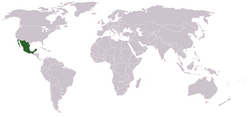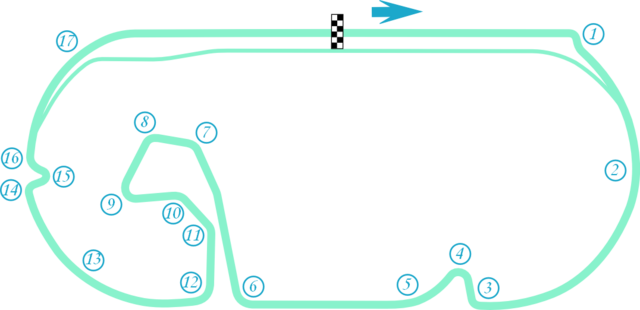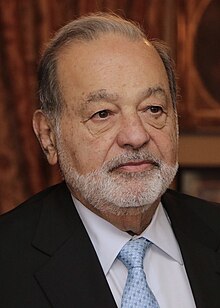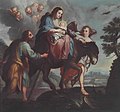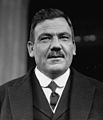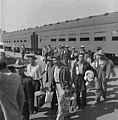Portal:Mexico
Wikipedia portal for content related to Mexico / From Wikipedia, the free encyclopedia
Portal maintenance status: (September 2019)
|
|
The Temple of Warriors at Chichen Itza, Mexico
¡Bienvenido! Welcome to the Mexico portal
Mexico, officially the United Mexican States, is a country in the southern portion of North America. It covers 1,972,550 km2 (761,610 sq mi), making it the world's 13th-largest country by area; with a population of almost 130 million, it is the 10th-most-populous country and the most populous Spanish-speaking country. Mexico is organized as a federal constitutional republic comprising 31 states and Mexico City, its capital. It shares land borders with the United States to the north, with Guatemala and Belize to the southeast; as well as maritime borders with the Pacific Ocean to the west, the Caribbean Sea to the southeast, and the Gulf of Mexico to the east.
| ||||||||||||||||||||||||||||
List of selected biographies |
|---|
In the news
- 6 April 2024 – 2024 raid on the Mexican embassy in Ecuador
- Nicaragua suspends diplomatic relations with Ecuador following the raid on the Mexican embassy in Quito, Ecuador. (Al Arabiya)
- 5 April 2024 – Ecuador–Mexico relations
- 2024 raid on the Mexican embassy in Ecuador
- After local police arrest former vice-president Jorge Glas at its embassy in Quito in violation of Article 22 of the Vienna Convention on Diplomatic Relations, Mexico suspends diplomatic relations with Ecuador. (The Guardian)
- 2 April 2024 – 2024 Mexican general election
- A mayoral candidate is assassinated in Celaya, Guanajuato, ahead of Mexico's upcoming general election. (CNN)
- 27 March 2024 –
- At least four people are killed by several wildfires across the State of Mexico, Mexico. (Reuters)
- 20 March 2024 – Mexican drug war
- Twelve bodies are found in Mexico, five inside a truck in the municipality of Villa Corona, Jalisco and seven in Sonora. (El Universal)
Selected fare or cuisine - show another

In the United States, Mexican Coca-Cola, or Mexican Coke (Spanish: Coca Cola de Vidrio, English: Glass Coca-Cola, or Coca-Cola in a glass bottle) or, informally, "Mexicoke", refers to Coca-Cola produced in and imported from Mexico. The Mexican formula that is exported into the U.S. is sweetened with white sugar instead of the high-fructose corn syrup used in the American formula since the early 1980s. Some tasters have said that Mexican Coca-Cola tastes better, while other blind tasting tests reported no perceptible differences in flavor.
Mexican Coke should not be confused with the domestic version of Coca-Cola sold in Mexico, which since 2017 may contain the artificial sweetener sucralose, with a can containing one-third less sugar than the export product. (Full article...)List of fare/cuisine articles |
|---|
General images
- Image 1Sawdust carpet made during "The night no one sleeps" in Huamantla, Tlaxcala (from Culture of Mexico)
- Image 3Lázaro Cárdenas mural (from History of Mexico)
- Image 5Modern group monument of Cortés, Doña Marina, and their mestizo son Martín (from History of Mexico)
- Image 6Panel 3 from Cancuen, Guatemala, representing king T'ah 'ak' Cha'an (from History of Mexico)
- Image 7Shield Jaguar and Lady Xoc, Maya, lintel 24 of temple 23, Yaxchilan, Mexico, ca. 725 ce. (from History of Mexico)
- Image 9Goddess, mural painting from the Tetitla apartment complex at Teotihuacan, Mexico, 650–750 CE (from History of Mexico)
- Image 10Gilberto Bosques Saldívar took the initiative to rescue tens of thousands of Jews and Spanish Republican exiles from being deported to Nazi Germany or Spain. (from History of Mexico)
- Image 11Colossal atlantids, pyramid B, Toltec, Tula, Mexico, ca. 900–1180 AD (from History of Mexico)
- Image 14Mexico City street market (from History of Mexico)
- Image 16Battle of Centla, the first time a horse was used in battle in a war in the Americas. Mural in the Palacio Municipal of Paraíso, Tabasco (from History of Mexico)
- Image 17Surrender of Santa Anna by William Henry Huddle shows the Mexican president and general surrendering to a wounded Sam Houston in 1836. (from History of Mexico)
- Image 18Cabinet Officers of Andrés Manuel López Obrador (left) and of Enrique Peña Nieto (right). (from History of Mexico)
- Image 20Entry into Mexico City by the Mexican army (from History of Mexico)
- Image 21"The Torture of Cuauhtémoc", a 19th-century painting by Leandro Izaguirre (from History of Mexico)
- Image 24Singer and actor Pedro Infante, one of the leading figures of the Golden Age of Mexican Cinema. (from Culture of Mexico)
- Image 25Spanish and Portuguese empires in 1790 (from History of Mexico)
- Image 26Logo of Nacional Financiera (NAFIN), the state development bank. (from History of Mexico)
- Image 27Logo of the Partido Nacional Revolucionario, with the colors of the Mexican flag (from History of Mexico)
- Image 28Mexican Central Railway train at station, Mexico (from History of Mexico)
- Image 29Variegated maize ears (from History of Mexico)
- Image 30Distribution of linguistic groups around 1500. (from Culture of Mexico)
- Image 34Pear, Quince and Psidium cajeta. In 2010 declared the Bicentennial Dessert of Mexico. (from Culture of Mexico)
- Image 36President Felipe Calderón with President of Brazil Luiz Inácio Lula da Silva. (from History of Mexico)
- Image 37Portrait and book by Sor Juana Inés de la Cruz, Baroque poet and writer. (from Culture of Mexico)
- Image 42La huida a Egipto (The Flight into Egypt). Miguel Cabrera, around 1700. (from Culture of Mexico)
- Image 43Toltec carving representing the Aztec Eagle, found in Veracruz, 10th–13th century. Metropolitan Museum of Art. (from History of Mexico)
- Image 44Porfirio Díaz (from History of Mexico)
- Image 45Chihuahua Cathedral and a monument to the city's founder, Antonio Deza y Ulloa (from History of Mexico)
- Image 46Sor Juana Inés de la Cruz (from History of Mexico)
- Image 47U.S. President Barack Obama and Mexican President-Elect Enrique Peña Nieto during their meet at the White House following Peña Nieto's election victory. (from History of Mexico)
- Image 48La leyenda de los volcanes (The legend of the volcanoes). Saturnino Herrán. 1910-1912. (from Culture of Mexico)
- Image 49Dining table, painted between 1857 y 1859, oleo sobre tela (oil on canvas) by Agustín Arrieta (from Culture of Mexico)
- Image 50A map of Mexico 1845 after Texas annexation by the U.S. (from History of Mexico)
- Image 51Cerro del Cubilete ("Dice Cup Hill"). At the top of the hill is the Cristo Rey (Christ the King) statue. (from Culture of Mexico)
- Image 53The Execution of Emperor Maximilian, 19 June 1867. Gen. Tomás Mejía, left, Maximilian, center, Gen. Miguel Miramón, right. Painting by Édouard Manet 1868. (from History of Mexico)
- Image 54The Castillo, Chichen Itza, Mexico, ca. 800–900 CE (from History of Mexico)
- Image 55Teotihuacan view of the Avenue of the Dead and the Pyramid of the Sun, from the Pyramid of the Moon (from History of Mexico)
- Image 58President Obregón. Note that he lost his right arm in the Battle of Celaya (1915), earning him the nickname of Manco de Celaya ("the one-armed man of Celaya"). (from History of Mexico)
- Image 60Buffalo Soldiers of the American 10th Cavalry Regiment taken prisoner during the Battle of Carrizal, Mexico in 1916. (from History of Mexico)
- Image 62Three world leaders: (background, left to right) Mexican President Carlos Salinas de Gortari, U.S. President George H. W. Bush, and Canadian Prime Minister Brian Mulroney, observe the signing of the North American Free Trade Agreement. (from History of Mexico)
- Image 64The first Braceros arrive in Los Angeles by train in 1942. Photograph by Dorothea Lange. (from History of Mexico)
- Image 65Chacmool, Maya, from the Platform of the Eagles, Chichen Itza, Mexico, ca. 800–90 CE (from History of Mexico)
- Image 66A unit of Cristeros preparing for battle. (from History of Mexico)
- Image 67Comanchería, territory controlled by the Comanches, prior to 1850 (from History of Mexico)
- Image 68Murals of Bonampak (between 580 and 800 AD) (from Culture of Mexico)
Categories
Topics
Related portals
WikiProject
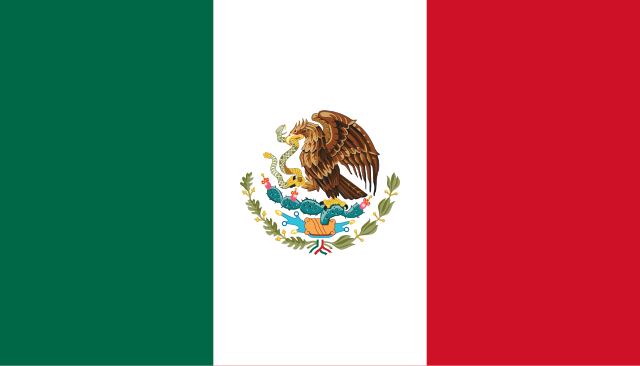
You are invited to participate in WikiProject Mexico, a WikiProject dedicated to developing and improving articles about Mexico.
Associated Wikimedia
| Mexico on Wikinews | Mexico on Wikiquote | Mexico on Wikibooks | Mexico on Wikisource | Mexico on Wiktionary | Mexico on Wikimedia Commons |
| News | Quotations | Manuals & Texts | Texts | Definitions | Images & Media |



